ECO mode FORD SIERRA 1982 1.G Braking System Workshop Manual
[x] Cancel search | Manufacturer: FORD, Model Year: 1982, Model line: SIERRA, Model: FORD SIERRA 1982 1.GPages: 22, PDF Size: 1.11 MB
Page 2 of 22
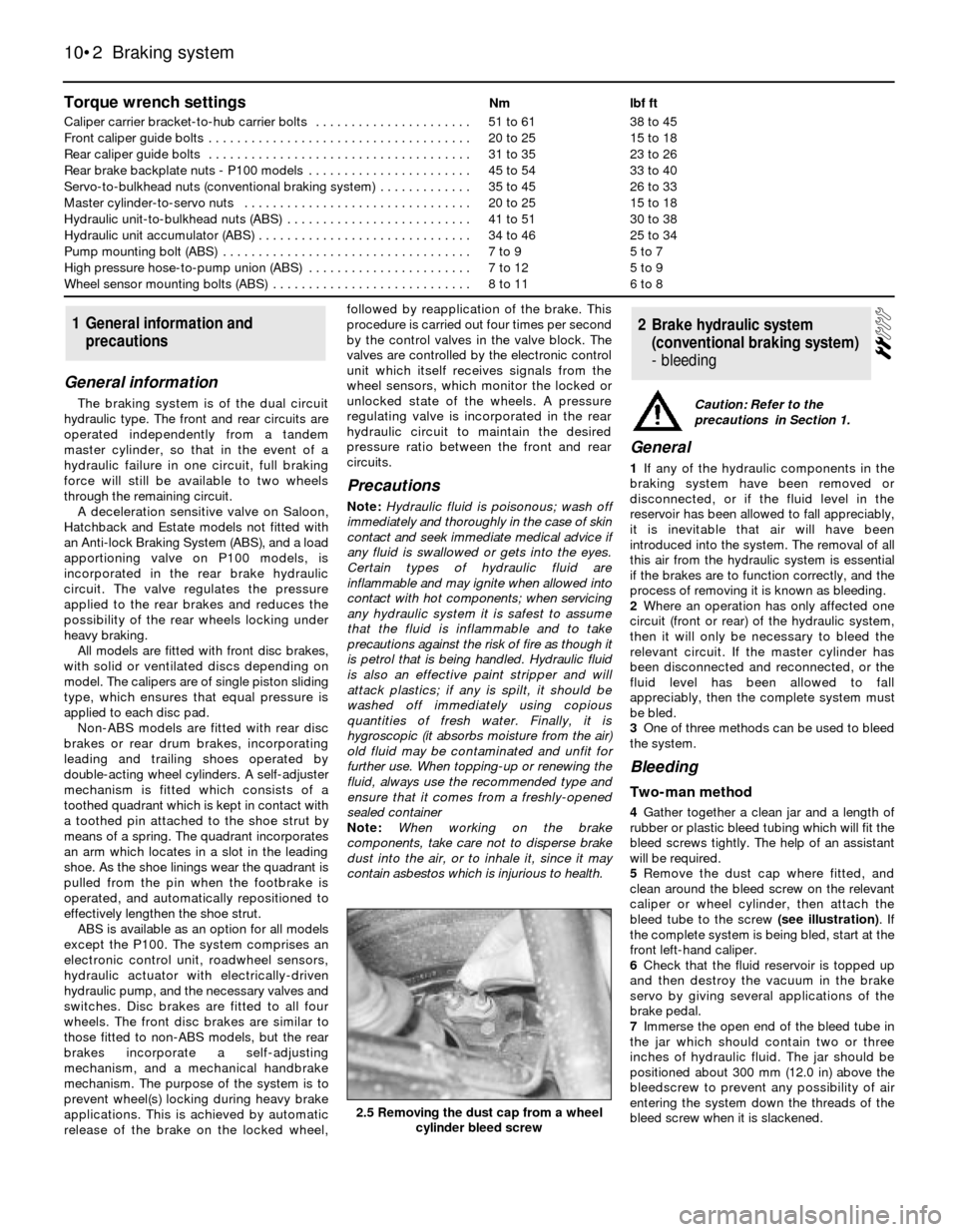
Torque wrench settingsNmlbf ft
Caliper carrier bracket-to-hub carrier bolts . . . . . . . . . . . . . . . . . . . . . .51 to 6138 to 45
Front caliper guide bolts . . . . . . . . . . . . . . . . . . . . . . . . . . . . . . . . . . . . .20 to 2515 to 18
Rear caliper guide bolts . . . . . . . . . . . . . . . . . . . . . . . . . . . . . . . . . . . . .31 to 3523 to 26
Rear brake backplate nuts - P100 models . . . . . . . . . . . . . . . . . . . . . . .45 to 5433 to 40
Servo-to-bulkhead nuts (conventional braking system) . . . . . . . . . . . . .35 to 4526 to 33
Master cylinder-to-servo nuts . . . . . . . . . . . . . . . . . . . . . . . . . . . . . . . .20 to 2515 to 18
Hydraulic unit-to-bulkhead nuts (ABS) . . . . . . . . . . . . . . . . . . . . . . . . . .41 to 5130 to 38
Hydraulic unit accumulator (ABS) . . . . . . . . . . . . . . . . . . . . . . . . . . . . . .34 to 4625 to 34
Pump mounting bolt (ABS) . . . . . . . . . . . . . . . . . . . . . . . . . . . . . . . . . . .7 to 95 to 7
High pressure hose-to-pump union (ABS) . . . . . . . . . . . . . . . . . . . . . . .7 to 125 to 9
Wheel sensor mounting bolts (ABS) . . . . . . . . . . . . . . . . . . . . . . . . . . . .8 to 116 to 8
General information
The braking system is of the dual circuit
hydraulic type. The front and rear circuits are
operated independently from a tandem
master cylinder, so that in the event of a
hydraulic failure in one circuit, full braking
force will still be available to two wheels
through the remaining circuit.
A deceleration sensitive valve on Saloon,
Hatchback and Estate models not fitted with
an Anti-lock Braking System (ABS), and a load
apportioning valve on P100 models, is
incorporated in the rear brake hydraulic
circuit. The valve regulates the pressure
applied to the rear brakes and reduces the
possibility of the rear wheels locking under
heavy braking.
All models are fitted with front disc brakes,
with solid or ventilated discs depending on
model. The calipers are of single piston sliding
type, which ensures that equal pressure is
applied to each disc pad.
Non-ABS models are fitted with rear disc
brakes or rear drum brakes, incorporating
leading and trailing shoes operated by
double-acting wheel cylinders. A self-adjuster
mechanism is fitted which consists of a
toothed quadrant which is kept in contact with
a toothed pin attached to the shoe strut by
means of a spring. The quadrant incorporates
an arm which locates in a slot in the leading
shoe. As the shoe linings wear the quadrant is
pulled from the pin when the footbrake is
operated, and automatically repositioned to
effectively lengthen the shoe strut.
ABS is available as an option for all models
except the P100. The system comprises an
electronic control unit, roadwheel sensors,
hydraulic actuator with electrically-driven
hydraulic pump, and the necessary valves and
switches. Disc brakes are fitted to all four
wheels. The front disc brakes are similar to
those fitted to non-ABS models, but the rear
brakes incorporate a self-adjusting
mechanism, and a mechanical handbrake
mechanism. The purpose of the system is to
prevent wheel(s) locking during heavy brake
applications. This is achieved by automatic
release of the brake on the locked wheel,followed by reapplication of the brake. This
procedure is carried out four times per second
by the control valves in the valve block. The
valves are controlled by the electronic control
unit which itself receives signals from the
wheel sensors, which monitor the locked or
unlocked state of the wheels. A pressure
regulating valve is incorporated in the rear
hydraulic circuit to maintain the desired
pressure ratio between the front and rear
circuits.
Precautions
Note: Hydraulic fluid is poisonous; wash off
immediately and thoroughly in the case of skin
contact and seek immediate medical advice if
any fluid is swallowed or gets into the eyes.
Certain types of hydraulic fluid are
inflammable and may ignite when allowed into
contact with hot components; when servicing
any hydraulic system it is safest to assume
that the fluid is inflammable and to take
precautions against the risk of fire as though it
is petrol that is being handled. Hydraulic fluid
is also an effective paint stripper and will
attack plastics; if any is spilt, it should be
washed off immediately using copious
quantities of fresh water. Finally, it is
hygroscopic (it absorbs moisture from the air)
old fluid may be contaminated and unfit for
further use. When topping-up or renewing the
fluid, always use the recommended type and
ensure that it comes from a freshly-opened
sealed container
Note: When working on the brake
components, take care not to disperse brake
dust into the air, or to inhale it, since it may
contain asbestos which is injurious to health.
General
1If any of the hydraulic components in the
braking system have been removed or
disconnected, or if the fluid level in the
reservoir has been allowed to fall appreciably,
it is inevitable that air will have been
introduced into the system. The removal of all
this air from the hydraulic system is essential
if the brakes are to function correctly, and the
process of removing it is known as bleeding.
2Where an operation has only affected one
circuit (front or rear) of the hydraulic system,
then it will only be necessary to bleed the
relevant circuit. If the master cylinder has
been disconnected and reconnected, or the
fluid level has been allowed to fall
appreciably, then the complete system must
be bled.
3One of three methods can be used to bleed
the system.
Bleeding
Two-man method
4Gather together a clean jar and a length of
rubber or plastic bleed tubing which will fit the
bleed screws tightly. The help of an assistant
will be required.
5Remove the dust cap where fitted, and
clean around the bleed screw on the relevant
caliper or wheel cylinder, then attach the
bleed tube to the screw (see illustration). If
the complete system is being bled, start at the
front left-hand caliper.
6Check that the fluid reservoir is topped up
and then destroy the vacuum in the brake
servo by giving several applications of the
brake pedal.
7Immerse the open end of the bleed tube in
the jar which should contain two or three
inches of hydraulic fluid. The jar should be
positioned about 300 mm (12.0 in) above the
bleedscrew to prevent any possibility of air
entering the system down the threads of the
bleed screw when it is slackened.
2Brake hydraulic system
(conventional braking system)
- bleeding1General information and
precautions
10•2Braking system
2.5 Removing the dust cap from a wheel
cylinder bleed screw
Caution: Refer to the
precautions in Section 1.
Page 3 of 22
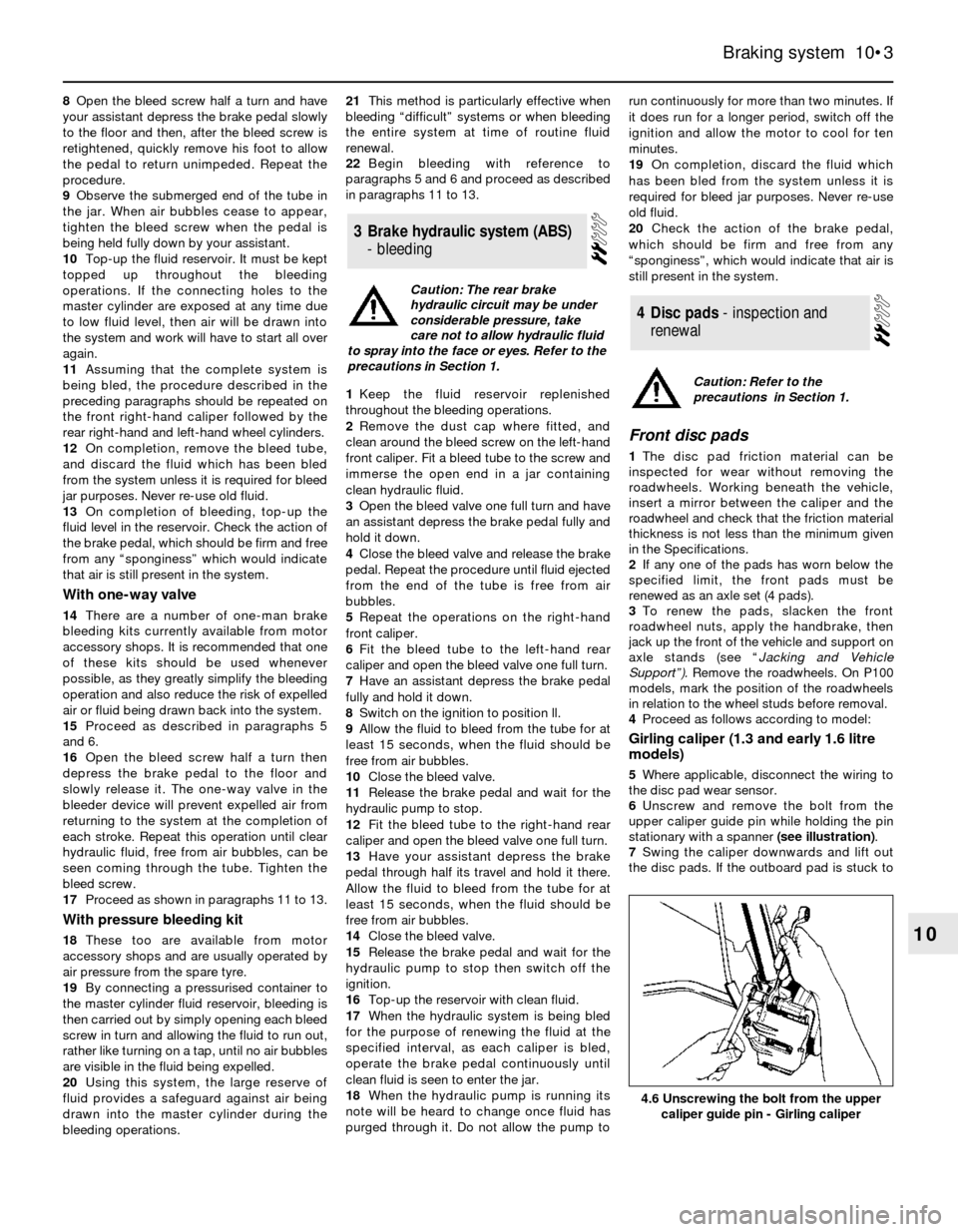
8Open the bleed screw half a turn and have
your assistant depress the brake pedal slowly
to the floor and then, after the bleed screw is
retightened, quickly remove his foot to allow
the pedal to return unimpeded. Repeat the
procedure.
9Observe the submerged end of the tube in
the jar. When air bubbles cease to appear,
tighten the bleed screw when the pedal is
being held fully down by your assistant.
10Top-up the fluid reservoir. It must be kept
topped up throughout the bleeding
operations. If the connecting holes to the
master cylinder are exposed at any time due
to low fluid level, then air will be drawn into
the system and work will have to start all over
again.
11Assuming that the complete system is
being bled, the procedure described in the
preceding paragraphs should be repeated on
the front right-hand caliper followed by the
rear right-hand and left-hand wheel cylinders.
12On completion, remove the bleed tube,
and discard the fluid which has been bled
from the system unless it is required for bleed
jar purposes. Never re-use old fluid.
13On completion of bleeding, top-up the
fluid level in the reservoir. Check the action of
the brake pedal, which should be firm and free
from any “sponginess” which would indicate
that air is still present in the system.
With one-way valve
14There are a number of one-man brake
bleeding kits currently available from motor
accessory shops. It is recommended that one
of these kits should be used whenever
possible, as they greatly simplify the bleeding
operation and also reduce the risk of expelled
air or fluid being drawn back into the system.
15Proceed as described in paragraphs 5
and 6.
16Open the bleed screw half a turn then
depress the brake pedal to the floor and
slowly release it. The one-way valve in the
bleeder device will prevent expelled air from
returning to the system at the completion of
each stroke. Repeat this operation until clear
hydraulic fluid, free from air bubbles, can be
seen coming through the tube. Tighten the
bleed screw.
17Proceed as shown in paragraphs 11 to 13.
With pressure bleeding kit
18These too are available from motor
accessory shops and are usually operated by
air pressure from the spare tyre.
19By connecting a pressurised container to
the master cylinder fluid reservoir, bleeding is
then carried out by simply opening each bleed
screw in turn and allowing the fluid to run out,
rather like turning on a tap, until no air bubbles
are visible in the fluid being expelled.
20Using this system, the large reserve of
fluid provides a safeguard against air being
drawn into the master cylinder during the
bleeding operations.21This method is particularly effective when
bleeding “difficult” systems or when bleeding
the entire system at time of routine fluid
renewal.
22Begin bleeding with reference to
paragraphs 5 and 6 and proceed as described
in paragraphs 11 to 13.
1Keep the fluid reservoir replenished
throughout the bleeding operations.
2Remove the dust cap where fitted, and
clean around the bleed screw on the left-hand
front caliper. Fit a bleed tube to the screw and
immerse the open end in a jar containing
clean hydraulic fluid.
3Open the bleed valve one full turn and have
an assistant depress the brake pedal fully and
hold it down.
4Close the bleed valve and release the brake
pedal. Repeat the procedure until fluid ejected
from the end of the tube is free from air
bubbles.
5Repeat the operations on the right-hand
front caliper.
6Fit the bleed tube to the left-hand rear
caliper and open the bleed valve one full turn.
7Have an assistant depress the brake pedal
fully and hold it down.
8Switch on the ignition to position ll.
9Allow the fluid to bleed from the tube for at
least 15 seconds, when the fluid should be
free from air bubbles.
10Close the bleed valve.
11Release the brake pedal and wait for the
hydraulic pump to stop.
12Fit the bleed tube to the right-hand rear
caliper and open the bleed valve one full turn.
13Have your assistant depress the brake
pedal through half its travel and hold it there.
Allow the fluid to bleed from the tube for at
least 15 seconds, when the fluid should be
free from air bubbles.
14Close the bleed valve.
15Release the brake pedal and wait for the
hydraulic pump to stop then switch off the
ignition.
16Top-up the reservoir with clean fluid.
17When the hydraulic system is being bled
for the purpose of renewing the fluid at the
specified interval, as each caliper is bled,
operate the brake pedal continuously until
clean fluid is seen to enter the jar.
18When the hydraulic pump is running its
note will be heard to change once fluid has
purged through it. Do not allow the pump torun continuously for more than two minutes. If
it does run for a longer period, switch off the
ignition and allow the motor to cool for ten
minutes.
19On completion, discard the fluid which
has been bled from the system unless it is
required for bleed jar purposes. Never re-use
old fluid.
20Check the action of the brake pedal,
which should be firm and free from any
“sponginess”, which would indicate that air is
still present in the system.
Front disc pads
1The disc pad friction material can be
inspected for wear without removing the
roadwheels. Working beneath the vehicle,
insert a mirror between the caliper and the
roadwheel and check that the friction material
thickness is not less than the minimum given
in the Specifications.
2If any one of the pads has worn below the
specified limit, the front pads must be
renewed as an axle set (4 pads).
3To renew the pads, slacken the front
roadwheel nuts, apply the handbrake, then
jack up the front of the vehicle and support on
axle stands (see “Jacking and Vehicle
Support”). Remove the roadwheels. On P100
models, mark the position of the roadwheels
in relation to the wheel studs before removal.
4Proceed as follows according to model:
Girling caliper (1.3 and early 1.6 litre
models)
5Where applicable, disconnect the wiring to
the disc pad wear sensor.
6Unscrew and remove the bolt from the
upper caliper guide pin while holding the pin
stationary with a spanner (see illustration).
7Swing the caliper downwards and lift out
the disc pads. If the outboard pad is stuck to
4Disc pads -inspectionand
renewal
3Brake hydraulic system (ABS)
- bleeding
Braking system 10•3
10
4.6 Unscrewing the bolt from the upper
caliper guide pin - Girling caliper
Caution: Refer to the
precautions in Section 1.
Caution: The rear brake
hydraulic circuit may be under
considerable pressure, take
care not to allow hydraulic fluid
to spray into the face or eyes. Refer to the
precautions in Section 1.
Page 11 of 22
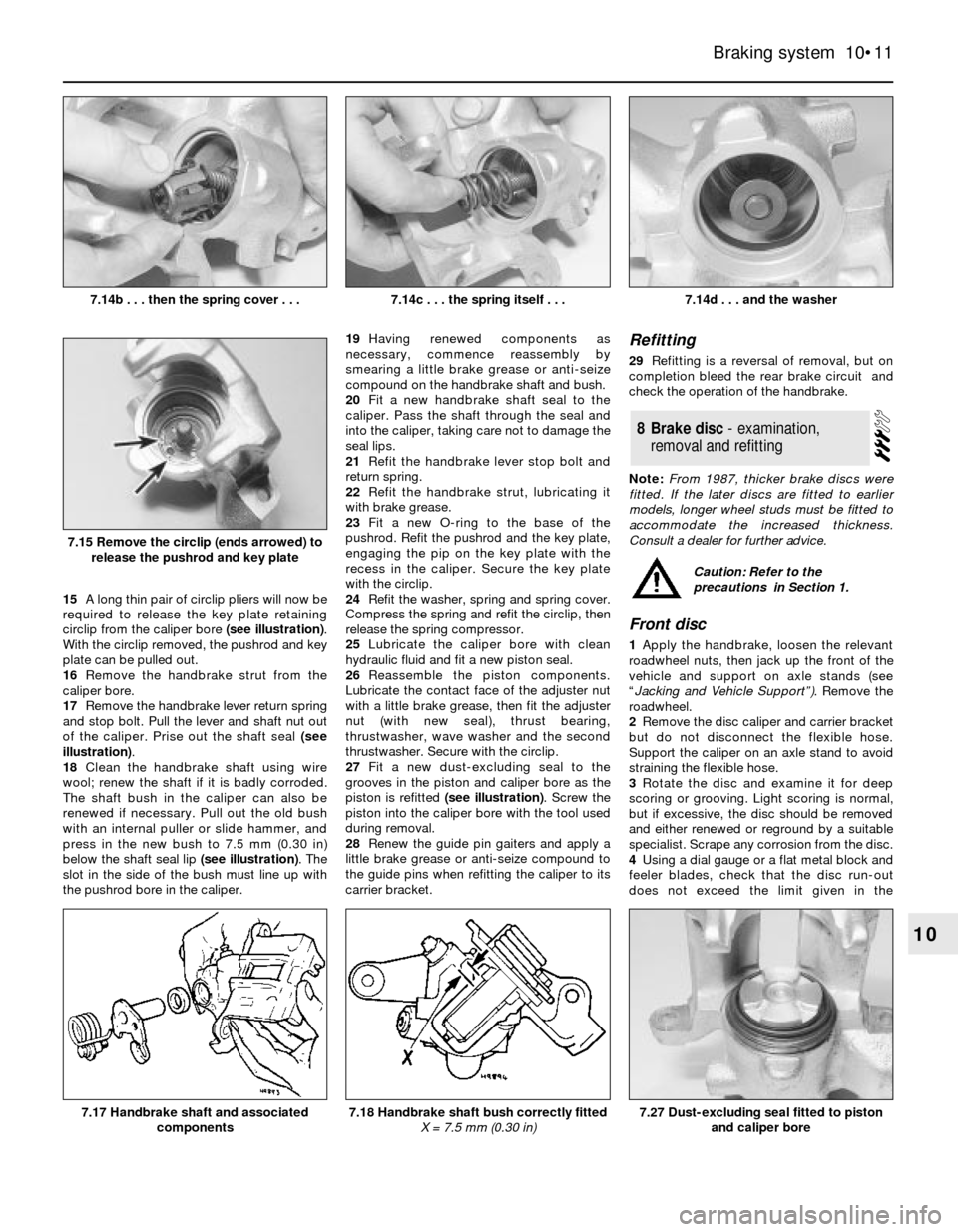
15A long thin pair of circlip pliers will now be
required to release the key plate retaining
circlip from the caliper bore (see illustration).
With the circlip removed, the pushrod and key
plate can be pulled out.
16Remove the handbrake strut from the
caliper bore.
17Remove the handbrake lever return spring
and stop bolt. Pull the lever and shaft nut out
of the caliper. Prise out the shaft seal (see
illustration).
18Clean the handbrake shaft using wire
wool; renew the shaft if it is badly corroded.
The shaft bush in the caliper can also be
renewed if necessary. Pull out the old bush
with an internal puller or slide hammer, and
press in the new bush to 7.5 mm (0.30 in)
below the shaft seal lip (see illustration). The
slot in the side of the bush must line up with
the pushrod bore in the caliper.19Having renewed components as
necessary, commence reassembly by
smearing a little brake grease or anti-seize
compound on the handbrake shaft and bush.
20Fit a new handbrake shaft seal to the
caliper. Pass the shaft through the seal and
into the caliper, taking care not to damage the
seal lips.
21Refit the handbrake lever stop bolt and
return spring.
22Refit the handbrake strut, lubricating it
with brake grease.
23Fit a new O-ring to the base of the
pushrod. Refit the pushrod and the key plate,
engaging the pip on the key plate with the
recess in the caliper. Secure the key plate
with the circlip.
24Refit the washer, spring and spring cover.
Compress the spring and refit the circlip, then
release the spring compressor.
25Lubricate the caliper bore with clean
hydraulic fluid and fit a new piston seal.
26Reassemble the piston components.
Lubricate the contact face of the adjuster nut
with a little brake grease, then fit the adjuster
nut (with new seal), thrust bearing,
thrustwasher, wave washer and the second
thrustwasher. Secure with the circlip.
27Fit a new dust-excluding seal to the
grooves in the piston and caliper bore as the
piston is refitted (see illustration). Screw the
piston into the caliper bore with the tool used
during removal.
28Renew the guide pin gaiters and apply a
little brake grease or anti-seize compound to
the guide pins when refitting the caliper to its
carrier bracket.
Refitting
29Refitting is a reversal of removal, but on
completion bleed the rear brake circuit and
check the operation of the handbrake.
Note: From 1987, thicker brake discs were
fitted. If the later discs are fitted to earlier
models, longer wheel studs must be fitted to
accommodate the increased thickness.
Consult a dealer for further advice.
Front disc
1Apply the handbrake, loosen the relevant
roadwheel nuts, then jack up the front of the
vehicle and support on axle stands (see
“Jacking and Vehicle Support”). Remove the
roadwheel.
2Remove the disc caliper and carrier bracket
but do not disconnect the flexible hose.
Support the caliper on an axle stand to avoid
straining the flexible hose.
3Rotate the disc and examine it for deep
scoring or grooving. Light scoring is normal,
but if excessive, the disc should be removed
and either renewed or reground by a suitable
specialist. Scrape any corrosion from the disc.
4Using a dial gauge or a flat metal block and
feeler blades, check that the disc run-out
does not exceed the limit given in the
8Brake disc - examination,
removal and refitting
Braking system 10•11
10
7.14d . . . and the washer
7.27 Dust-excluding seal fitted to piston
and caliper bore7.18 Handbrake shaft bush correctly fitted
X = 7.5 mm (0.30 in)7.17 Handbrake shaft and associated
components
7.15 Remove the circlip (ends arrowed) to
release the pushrod and key plate
7.14c . . . the spring itself . . .7.14b . . . then the spring cover . . .
Caution: Refer to the
precautions in Section 1.
Page 12 of 22
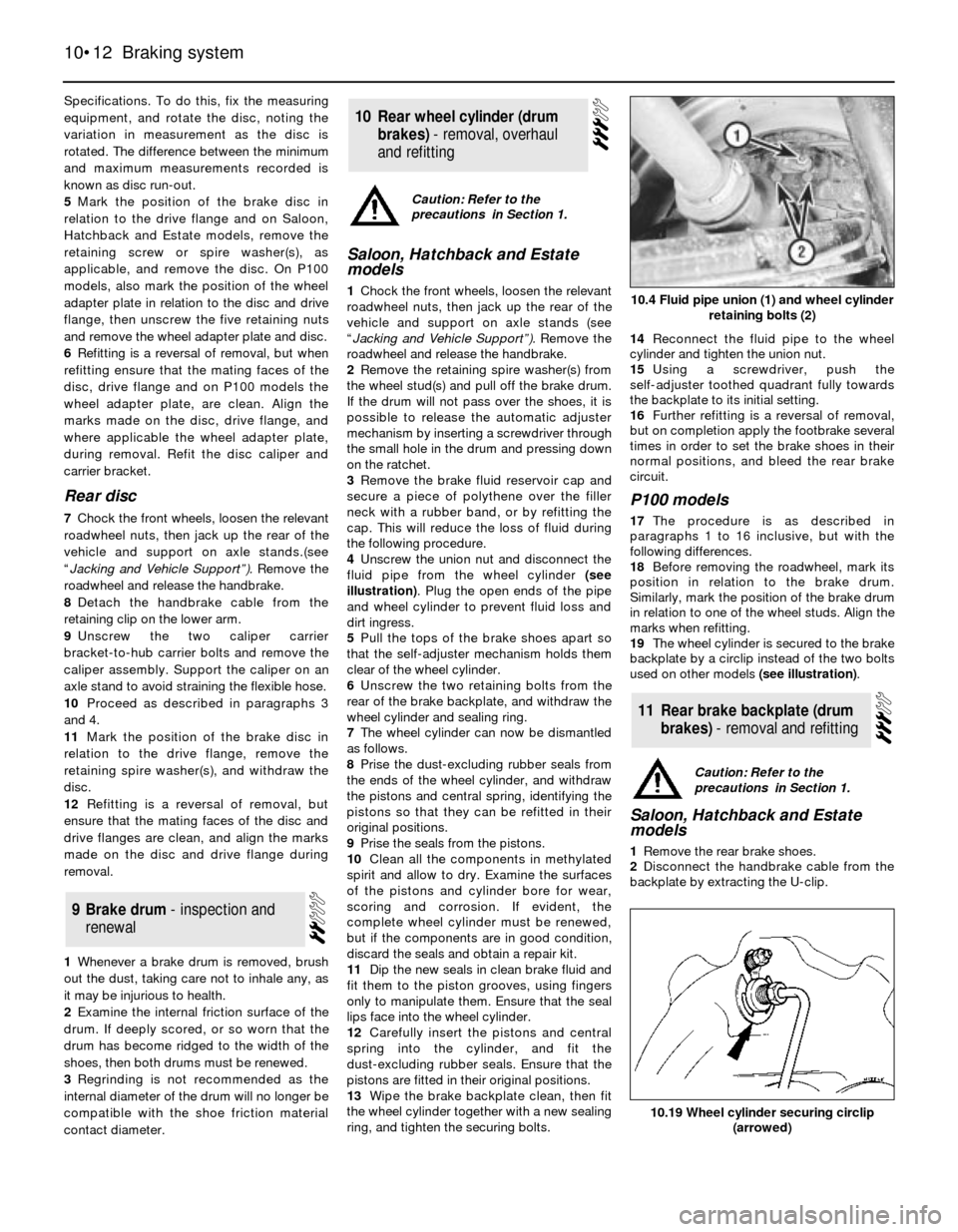
Specifications. To do this, fix the measuring
equipment, and rotate the disc, noting the
variation in measurement as the disc is
rotated. The difference between the minimum
and maximum measurements recorded is
known as disc run-out.
5Mark the position of the brake disc in
relation to the drive flange and on Saloon,
Hatchback and Estate models, remove the
retaining screw or spire washer(s), as
applicable, and remove the disc. On P100
models, also mark the position of the wheel
adapter plate in relation to the disc and drive
flange, then unscrew the five retaining nuts
and remove the wheel adapter plate and disc.
6Refitting is a reversal of removal, but when
refitting ensure that the mating faces of the
disc, drive flange and on P100 models the
wheel adapter plate, are clean. Align the
marks made on the disc, drive flange, and
where applicable the wheel adapter plate,
during removal. Refit the disc caliper and
carrier bracket.
Rear disc
7Chock the front wheels, loosen the relevant
roadwheel nuts, then jack up the rear of the
vehicle and support on axle stands.(see
“Jacking and Vehicle Support”).Remove the
roadwheel and release the handbrake.
8Detach the handbrake cable from the
retaining clip on the lower arm.
9Unscrew the two caliper carrier
bracket-to-hub carrier bolts and remove the
caliper assembly. Support the caliper on an
axle stand to avoid straining the flexible hose.
10Proceed as described in paragraphs 3
and 4.
11Mark the position of the brake disc in
relation to the drive flange, remove the
retaining spire washer(s), and withdraw the
disc.
12Refitting is a reversal of removal, but
ensure that the mating faces of the disc and
drive flanges are clean, and align the marks
made on the disc and drive flange during
removal.
1Whenever a brake drum is removed, brush
out the dust, taking care not to inhale any, as
it may be injurious to health.
2Examine the internal friction surface of the
drum. If deeply scored, or so worn that the
drum has become ridged to the width of the
shoes, then both drums must be renewed.
3Regrinding is not recommended as the
internal diameter of the drum will no longer be
compatible with the shoe friction material
contact diameter.
Saloon, Hatchback and Estate
models
1Chock the front wheels, loosen the relevant
roadwheel nuts, then jack up the rear of the
vehicle and support on axle stands (see
“Jacking and Vehicle Support”).Remove the
roadwheel and release the handbrake.
2Remove the retaining spire washer(s) from
the wheel stud(s) and pull off the brake drum.
If the drum will not pass over the shoes, it is
possible to release the automatic adjuster
mechanism by inserting a screwdriver through
the small hole in the drum and pressing down
on the ratchet.
3Remove the brake fluid reservoir cap and
secure a piece of polythene over the filler
neck with a rubber band, or by refitting the
cap. This will reduce the loss of fluid during
the following procedure.
4Unscrew the union nut and disconnect the
fluid pipe from the wheel cylinder (see
illustration). Plug the open ends of the pipe
and wheel cylinder to prevent fluid loss and
dirt ingress.
5Pull the tops of the brake shoes apart so
that the self-adjuster mechanism holds them
clear of the wheel cylinder.
6Unscrew the two retaining bolts from the
rear of the brake backplate, and withdraw the
wheel cylinder and sealing ring.
7The wheel cylinder can now be dismantled
as follows.
8Prise the dust-excluding rubber seals from
the ends of the wheel cylinder, and withdraw
the pistons and central spring, identifying the
pistons so that they can be refitted in their
original positions.
9Prise the seals from the pistons.
10Clean all the components in methylated
spirit and allow to dry. Examine the surfaces
of the pistons and cylinder bore for wear,
scoring and corrosion. If evident, the
complete wheel cylinder must be renewed,
but if the components are in good condition,
discard the seals and obtain a repair kit.
11Dip the new seals in clean brake fluid and
fit them to the piston grooves, using fingers
only to manipulate them. Ensure that the seal
lips face into the wheel cylinder.
12Carefully insert the pistons and central
spring into the cylinder, and fit the
dust-excluding rubber seals. Ensure that the
pistons are fitted in their original positions.
13Wipe the brake backplate clean, then fit
the wheel cylinder together with a new sealing
ring, and tighten the securing bolts.14Reconnect the fluid pipe to the wheel
cylinder and tighten the union nut.
15Using a screwdriver, push the
self-adjuster toothed quadrant fully towards
the backplate to its initial setting.
16Further refitting is a reversal of removal,
but on completion apply the footbrake several
times in order to set the brake shoes in their
normal positions, and bleed the rear brake
circuit.
P100 models
17The procedure is as described in
paragraphs 1 to 16 inclusive, but with the
following differences.
18Before removing the roadwheel, mark its
position in relation to the brake drum.
Similarly, mark the position of the brake drum
in relation to one of the wheel studs. Align the
marks when refitting.
19The wheel cylinder is secured to the brake
backplate by a circlip instead of the two bolts
used on other models (see illustration).
Saloon, Hatchback and Estate
models
1Remove the rear brake shoes.
2Disconnect the handbrake cable from the
backplate by extracting the U-clip.
11Rear brake backplate (drum
brakes) - removal and refitting
10Rear wheel cylinder (drum
brakes) -removal,overhaul
andrefitting
9Brake drum -inspectionand
renewal
10•12Braking system
10.4 Fluid pipe union (1) and wheel cylinder
retaining bolts (2)
10.19 Wheel cylinder securing circlip
(arrowed)
Caution: Refer to the
precautions in Section 1.
Caution: Refer to the
precautions in Section 1.
Page 19 of 22
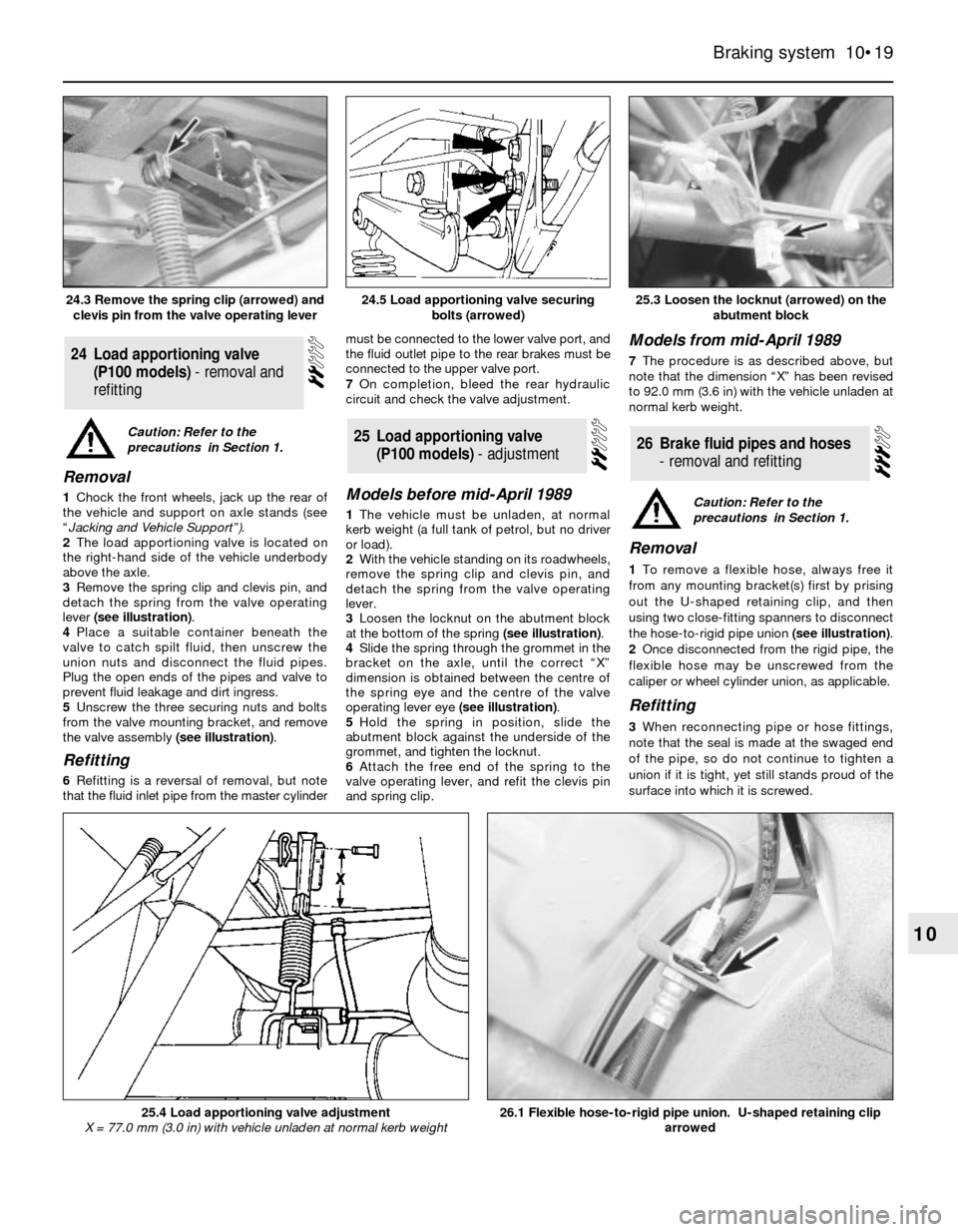
Removal
1Chock the front wheels, jack up the rear of
the vehicle and support on axle stands (see
“Jacking and Vehicle Support”).
2The load apportioning valve is located on
the right-hand side of the vehicle underbody
above the axle.
3Remove the spring clip and clevis pin, and
detach the spring from the valve operating
lever (see illustration).
4Place a suitable container beneath the
valve to catch spilt fluid, then unscrew the
union nuts and disconnect the fluid pipes.
Plug the open ends of the pipes and valve to
prevent fluid leakage and dirt ingress.
5Unscrew the three securing nuts and bolts
from the valve mounting bracket, and remove
the valve assembly (see illustration).
Refitting
6Refitting is a reversal of removal, but note
that the fluid inlet pipe from the master cylindermust be connected to the lower valve port, and
the fluid outlet pipe to the rear brakes must be
connected to the upper valve port.
7On completion, bleed the rear hydraulic
circuit and check the valve adjustment.
Models before mid-April 1989
1The vehicle must be unladen, at normal
kerb weight (a full tank of petrol, but no driver
or load).
2With the vehicle standing on its roadwheels,
remove the spring clip and clevis pin, and
detach the spring from the valve operating
lever.
3Loosen the locknut on the abutment block
at the bottom of the spring (see illustration).
4Slide the spring through the grommet in the
bracket on the axle, until the correct “X”
dimension is obtained between the centre of
the spring eye and the centre of the valve
operating lever eye (see illustration).
5Hold the spring in position, slide the
abutment block against the underside of the
grommet, and tighten the locknut.
6Attach the free end of the spring to the
valve operating lever, and refit the clevis pin
and spring clip.
Models from mid-April 1989
7The procedure is as described above, but
note that the dimension “X” has been revised
to 92.0 mm (3.6 in) with the vehicle unladen at
normal kerb weight.
Removal
1To remove a flexible hose, always free it
from any mounting bracket(s) first by prising
out the U-shaped retaining clip, and then
using two close-fitting spanners to disconnect
the hose-to-rigid pipe union (see illustration).
2Once disconnected from the rigid pipe, the
flexible hose may be unscrewed from the
caliper or wheel cylinder union, as applicable.
Refitting
3When reconnecting pipe or hose fittings,
note that the seal is made at the swaged end
of the pipe, so do not continue to tighten a
union if it is tight, yet still stands proud of the
surface into which it is screwed.
26Brake fluid pipes and hoses
- removal and refitting25Load apportioning valve
(P100 models) - adjustment
24Load apportioning valve
(P100 models) - removal and
refitting
Braking system 10•19
10
25.3 Loosen the locknut (arrowed) on the
abutment block
26.1 Flexible hose-to-rigid pipe union. U-shaped retaining clip
arrowed25.4 Load apportioning valve adjustment
X = 77.0 mm (3.0 in) with vehicle unladen at normal kerb weight
24.5 Load apportioning valve securing
bolts (arrowed)24.3 Remove the spring clip (arrowed) and
clevis pin from the valve operating lever
Caution: Refer to the
precautions in Section 1.
Caution: Refer to the
precautions in Section 1.